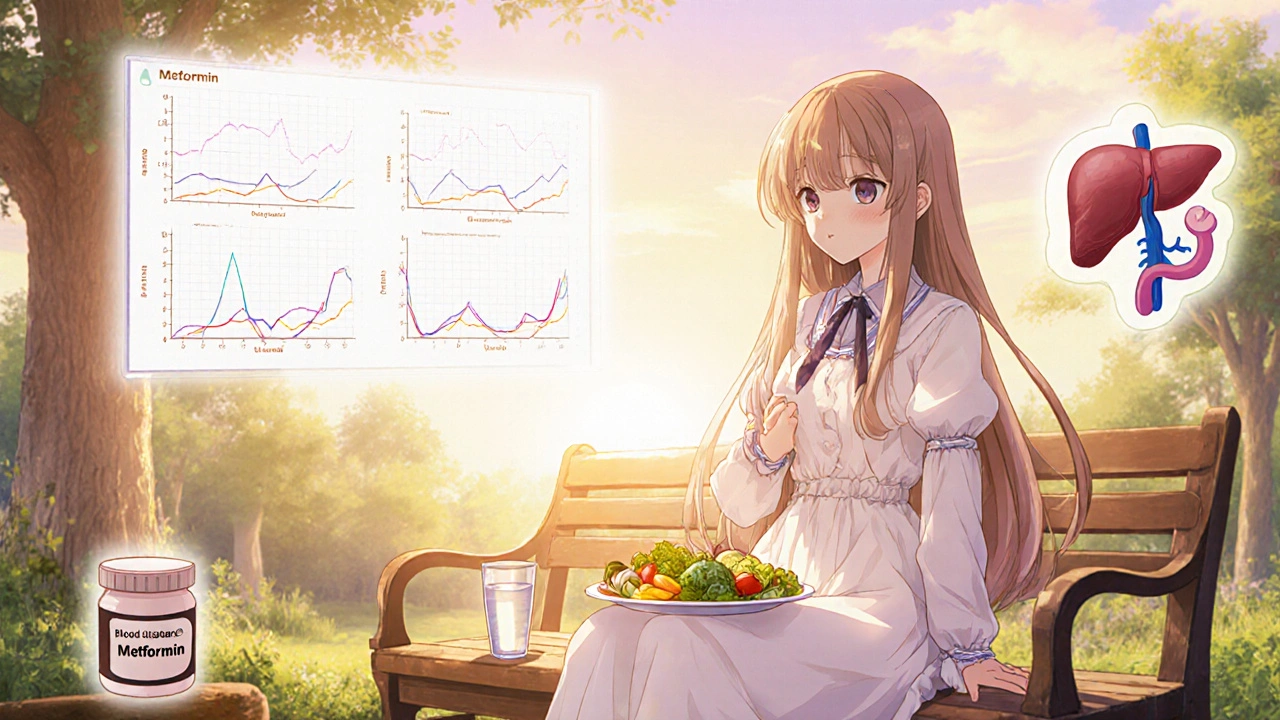Liver & Diabetes Risk Assessment Tool
This tool helps you understand your risk of developing diabetes if you have liver disease, or vice versa. Answer the questions below to get a personalized risk assessment based on clinical evidence from the article.
Understanding the link between liver failure and diabetes can feel like piecing together a medical puzzle. When the liver starts to falter, your blood‑sugar control can flip upside down, and the reverse is true, too. This guide walks you through what’s happening inside the body, why it matters, and what you can do to stay ahead of both problems.
What is Liver Failure?
Liver Failure is a severe loss of liver function that can develop suddenly (acute) or over years (chronic). When healthy liver tissue is replaced by scar tissue, toxins build up, clotting factors drop, and the organ can no longer regulate metabolism, detoxify chemicals, or store nutrients effectively. Common causes include viral hepatitis, excessive alcohol use, and non‑alcoholic fatty liver disease (NAFLD). Once the liver can’t keep up, you may see jaundice, fluid buildup, and mental confusion.
What is Diabetes?
Diabetes is a chronic condition where the body either doesn’t produce enough insulin or can’t use it properly, leading to high blood‑sugar levels. There are two main types: Type 1, an autoimmune attack on insulin‑producing beta cells, and Type 2, which stems from insulin resistance and often ties to obesity and metabolic syndrome. Persistent hyperglycemia damages blood vessels, nerves, and organs-including the liver.
Why Liver Failure Messes With Blood Sugar
The liver plays a starring role in glucose metabolism. It stores excess glucose as glycogen, releases it between meals, and clears excess sugar from the bloodstream. When liver cells die or scar, several key processes break down:
- Impaired glycogen storage: The liver can’t stash glucose, so blood sugar spikes after meals.
- Reduced gluconeogenesis control: The organ continues producing glucose even when it’s not needed, adding to hyperglycemia.
- Hormonal imbalance: Damaged liver tissue releases inflammatory cytokines that worsen insulin resistance, making cells less responsive to insulin.
All three pathways push the pancreas to work harder, eventually wearing out beta cells-a condition known as beta‑cell dysfunction. The result? A higher chance of developing Type 2 diabetes.

Shared Risk Factors: When Liver Trouble and Diabetes Collide
Some health issues act as a two‑way street, increasing the odds of both liver failure and diabetes:
| Condition | Primary Cause | Impact on Blood Sugar | Typical Diabetes Risk |
|---|---|---|---|
| Non‑Alcoholic Fatty Liver Disease (NAFLD) | Obesity, insulin resistance | Increases hepatic insulin resistance | High (up to 45% develop Type 2) |
| Alcoholic Liver Disease | Chronic heavy alcohol intake | Disrupts gluconeogenesis, raises cortisol | Moderate (alcohol‑related insulin resistance) |
| Cirrhosis | Advanced scarring from any cause | Impaired glucose storage, chronic inflammation | High (approx. 30% prevalence) |
| Portal Hypertension | Increased pressure in portal vein | Alters gut‑liver axis, worsens metabolic tone | Low‑to‑moderate (indirect effect) |
Notice how NAFLD tops the list. It’s essentially a liver manifestation of metabolic syndrome, the same cluster of risk factors-high triglycerides, low HDL, hypertension-that fuels Type 2 diabetes.
Clinical Evidence: Numbers That Matter
Recent cohort studies reinforce the connection. A 2023 meta‑analysis of 12,000 patients with chronic liver disease found that 38% also had diabetes, compared with 12% in the general population. Another 2024 longitudinal study tracked 5,000 NAFLD patients for ten years; 42% progressed to diabetes, and those who developed cirrhosis had a 1.7‑fold higher hazard ratio.
Why do these numbers matter? They tell clinicians to screen liver patients for fasting glucose, HbA1c, and oral‑glucose tolerance, and vice‑versa-testing diabetics for liver enzymes (ALT, AST) and imaging when risk factors line up.

Managing Both Conditions: A Practical Checklist
Keeping blood sugar stable while protecting liver health boils down to three pillars: diet, medication, and monitoring.
- Diet that pleases both organs
- Limit added sugars and refined carbs-these spike glucose and add liver fat.
- Choose lean protein and plant‑based fats (olive oil, nuts) to support insulin sensitivity.
- Reduce alcohol. Even moderate intake can worsen cirrhosis and raise insulin resistance.
- Medication coordination
- Metformin remains first‑line for Type 2 diabetes and may slow NAFLD progression.
- Statins control cholesterol and have a neutral‑to‑positive effect on liver enzymes.
- For advanced liver disease, avoid drugs cleared primarily by the liver (e.g., certain sulfonylureas).
- Regular monitoring
- Check fasting glucose or HbA1c every 3‑6 months.
- Panel liver function tests (ALT, AST, bilirubin) at the same interval.
- Ultrasound or FibroScan if you have risk factors for fibrosis.
Small, consistent actions can turn a double‑danger scenario into manageable health.
When to Seek Immediate Care
If you notice any of these red flags, get medical attention right away:
- Sudden jaundice (yellow skin or eyes)
- Severe abdominal pain or swelling
- Confusion, drowsiness, or rapid weight loss
- Persistent blood‑sugar readings above 250 mg/dL (13.9 mmol/L)
- Unexplained bruising or bleeding
These signs may signal that liver function is dropping fast or that diabetes is spiraling out of control, both of which need urgent treatment.
Frequently Asked Questions
Can diabetes cause liver failure?
Yes. Chronic high blood sugar can damage liver cells, promote fat accumulation, and accelerate fibrosis, especially when combined with obesity or alcohol use.
Is NAFLD reversible?
In early stages, lifestyle changes-weight loss, balanced diet, and regular exercise-can reduce liver fat and improve insulin sensitivity, often reversing the disease.
What screening tests should I get?
For liver health, get ALT, AST, alkaline phosphatase, bilirubin, and a liver ultrasound or FibroScan. For diabetes, check fasting glucose, HbA1c, and consider an oral‑glucose tolerance test if you have risk factors.
Can I exercise if I have cirrhosis?
Mild to moderate activity (walking, cycling) is usually safe and can improve insulin sensitivity. Always get clearance from your hepatologist before starting a new routine.
Do any diabetes medicines harm the liver?
Most modern agents (metformin, GLP‑1 agonists, SGLT2 inhibitors) are liver‑friendly. However, some older sulfonylureas and high‑dose thiazolidinediones require careful monitoring.
Staying informed is the first step. By watching your liver health and blood‑sugar numbers together, you can catch problems early and keep both organs working smoothly.





laura wood
I've seen many patients struggle with both liver issues and blood‑sugar spikes, and the key is to treat them as interconnected rather than isolated problems. Cutting out added sugars, focusing on lean protein, and keeping alcohol intake low can protect both the liver and insulin sensitivity. Regular check‑ups for liver enzymes and HbA1c every few months give you a clear picture of how the two are influencing each other. Small, consistent lifestyle tweaks are far more sustainable than drastic diets that you can't keep up with.
Kate McKay
Think of your liver and pancreas as a team that needs the same coaching. When you lose weight gradually – even just a 5‑10% reduction – you often see both liver fat shrink and insulin resistance drop. Pair that with daily walks or light cardio, and you give your organs a chance to recover. Remember to log your blood‑sugar readings and liver panel results side by side; trends become obvious when you can see them together.
Demetri Huyler
What a parade of jargon, everyone.
JessicaAnn Sutton
While flamboyant language can be entertaining, the underlying clinical reality should not be obscured. The liver's inability to store glycogen properly directly contributes to post‑prandial hyperglycemia, and chronic inflammatory cytokines exacerbate insulin resistance. Ignoring these mechanisms does a disservice to patients who need clear, evidence‑based guidance.
Israel Emory
Let's keep the conversation constructive; both conditions share modifiable risk factors, and collaboration is essential. Reducing processed carbs, prioritizing fiber, and staying hydrated support hepatic detoxification and improve glucose handling. If you feel overwhelmed, reach out to a multidisciplinary team – they can tailor a plan that respects both liver and pancreas health.
Sebastian Green
I appreciate the balanced tone. In my experience, having a supportive clinician who checks both labs in tandem makes a big difference. I've found that noting subtle shifts in ALT or fasting glucose early can prompt timely interventions before complications arise.
Wesley Humble
It is imperative to recognize that the pathophysiology linking hepatic insufficiency and dysglycemia is not merely anecdotal but grounded in a robust corpus of peer‑reviewed literature. First, hepatic glucokinase activity diminishes in the context of cirrhotic remodeling, resulting in impaired hepatic uptake of glucose post‑prandially. Second, the hepatic synthesis of insulin‑like growth factor‑1 (IGF‑1) is attenuated, which influences peripheral insulin sensitivity. Third, chronic inflammation mediated by tumor necrosis factor‑alpha and interleukin‑6 augments serine phosphorylation of the insulin receptor substrate, thereby blunting downstream signaling cascades. Fourth, altered bile acid composition in cholestatic disease has been shown to influence the farnesoid X receptor (FXR), a nuclear receptor that modulates gluconeogenesis. Fifth, the portal hypertension seen in advanced fibrosis alters gut‑derived endotoxin translocation, further potentiating systemic insulin resistance. Sixth, hepatic steatosis, a hallmark of NAFLD, precipitates lipotoxicity that directly impairs β‑cell function via ceramide accumulation. Seventh, the reduced hepatic clearance of insulin in liver disease leads to hyperinsulinemia, which paradoxically can exacerbate peripheral insulin resistance. Eighth, the metabolic derangements associated with alcoholic liver disease, such as elevated NADH/NAD⁺ ratios, shift hepatic redox state and favor gluconeogenic flux. Ninth, genetic polymorphisms in PNPLA3 and TM6SF2, which predispose to fatty liver, have also been correlated with impaired glucose tolerance. Tenth, the endocrine function of the liver, including the production of hepatokines like fibroblast growth factor‑21 (FGF‑21), is compromised, further dysregulating glucose homeostasis. Eleventh, pharmacologic agents cleared hepatically, such as certain sulfonylureas, may accumulate and precipitate hypoglycemic episodes when liver function declines. Twelfth, the interrelationship between hepatic insulin clearance and pancreatic insulin secretion creates a feedback loop that can accelerate β‑cell exhaustion. Thirteenth, imaging modalities such as FibroScan have demonstrated that higher liver stiffness measurements correlate with higher HbA1c values independent of BMI. Fourteenth, clinical trials have shown that metformin not only improves insulin sensitivity but also attenuates hepatic fibrogenesis, suggesting a dual therapeutic benefit. Finally, comprehensive management necessitates an integrated approach: lifestyle modification targeting weight reduction, judicious pharmacotherapy respecting hepatic metabolism, and regular surveillance of both hepatic panels and glycemic indices. Only through such multidisciplinary vigilance can clinicians mitigate the bidirectional burden of liver failure and diabetes.
barnabas jacob
Yo, that was a massive dump of brain‑fart. Basically, liver sucks at processing sugar when it’s messed up, so your pancreas has to work overtime. If you keep chugging booze or piling on carbs, you’ll just fuel the fire. Bottom line: cut the junk, move more, and don’t expect miracle pills to fix a busted liver.